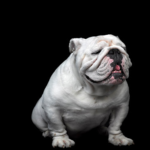Left: a rendering of what a bulldog would have looked like in the early 1800s.
Bulldogs are significantly more likely than other dogs to suffer from a wide range of health issues, including ear and eye problems, skin infections, respiratory issues, immunological and neurological problems and locomotor challenges, according to Brenda Bonnett, a consulting veterinary epidemiologist.
“Many would question whether the breed’s quality of life is so compromised that its breeding should be banned,” wrote Dr. Nicola Rooney and Dr. David Sargan of the English bulldog in their report, “Pedigree Dog Breeding in the U.K.: A Major Welfare Concern?” Veterinarians in the U.S. are now wondering the same thing.
Diane Judy, a former bulldog breeder from Tennessee who bred the current Yale mascot, told Denizet-Lewis before her death last year that she “adores” bulldogs but no longer felt comfortable breeding them. “They aren’t athletic or especially healthy,” she said. “Most can’t have sex without help — they’re too short and stocky. Most can’t give birth on their own — their heads are too big. A breed that has trouble doing those two things is, by definition, in trouble.”
I love seeing this discussed outside of circles of animal lovers and purebred dog enthusiasts.
Ancient and contemporary bulldog skulls compared to illustrate how breeders have altered skull and jaw in 300 years. The concentrated repetition of aberrant mutations of the cranium and ‘upper’ jaw (maxilla) has resulted in this defect.
(Source)
English Bulldog skull.
(Source)

Just another WordPress site



